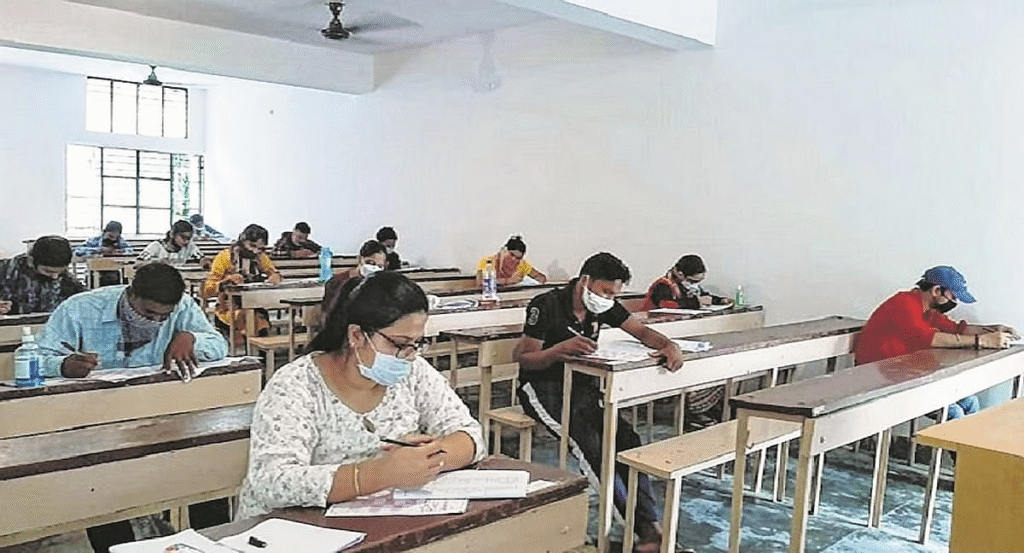
In a landmark development for higher education in India, the National Testing Agency (NTA) has officially announced the results of the Common University Entrance Test for Postgraduate programs (CUET PG) 2025. This announcement marks a significant moment for lakhs of students across the country who participated in this centralized entrance examination, aspiring to pursue advanced academic degrees in diverse fields of study. Conducted with the aim of streamlining the admission process and bringing uniformity across various central and state universities, CUET PG has grown into a critical milestone for candidates planning to advance their academic careers.
With results now available on the official NTA portal at exams.nta.ac.in, candidates can log in using their application number and date of birth to download their scorecards. As the digital portal witnesses a surge in traffic from anxious and hopeful students, this outcome opens new doors for admission to over 200 universities participating in the CUET PG framework. These include some of India’s most reputed institutions offering a wide range of postgraduate programs across science, commerce, humanities, social sciences, and more.
A Record-Breaking Participation and a Seamless Digital Conduct
The 2025 edition of CUET PG saw an unprecedented response from the student community. Over 4.1 lakh candidates registered for the examination, spanning 157 subject tests. These figures reflect the growing trust students are placing in a unified, computer-based testing model that is designed to ensure fairness, transparency, and merit-based selection.
Held between March 13 and April 1, 2025, the CUET PG exam was conducted in 43 shifts across 312 cities, including 27 international locations such as Dubai, Riyadh, Kathmandu, Colombo, and even European cities like Frankfurt and Oslo. This marked a significant evolution in the reach and accessibility of the Indian higher education entrance ecosystem, reflecting both its global relevance and digital transformation.
The exam was carried out in the Computer-Based Test (CBT) mode, with an aim to eliminate inconsistencies in the offline format and standardize candidate assessment across regions. Every measure was taken to ensure security, fairness, and inclusivity — from Aadhaar-based biometric verification systems to CCTV monitoring and deployment of signal jammers at centers. In addition, the NTA issued a detailed advisory in advance, guiding students on what to bring, what to avoid, and how to conduct themselves during exam hours.
Major Reforms Introduced in CUET PG 2025
This year’s CUET PG introduced a slew of changes aimed at improving the candidate experience and simplifying logistics. One of the most notable changes was the reduction in examination duration — from 105 minutes to 90 minutes — while retaining the 75-question format. This allowed for a more concise yet effective testing environment. Students had the freedom to select up to four subject test codes, which increased flexibility for interdisciplinary learners and those applying to multiple programs.
Additionally, the application fee was revised for all categories. General category candidates were required to pay ₹1,400, while candidates from OBC-NCL and EWS categories paid ₹1,200. Although this represented a hike of ₹200 from the previous year, the increase was justified by the expanded subject offerings, better logistics, and added international test centers.
Furthermore, the number of participating universities increased this year, allowing students greater scope in choosing programs and institutions aligned with their interests and career goals. With private, deemed, and state-level universities also participating alongside central universities, CUET PG 2025 emerged as one of the most inclusive higher education entrance platforms in India.
The Countdown to the Results: Anticipation and Anxiety
The weeks following the examination were filled with nervous anticipation for students and their families. As the NTA completed its meticulous evaluation of lakhs of answer sheets, the education ecosystem closely monitored for updates. Social media platforms were abuzz with student communities sharing speculations, cut-off predictions, and support for peers. Coaching centers released unofficial answer keys and expected percentile ranges, keeping the atmosphere charged.
Students had a chance to challenge the provisional answer key released earlier by NTA, which was a step toward transparency and fairness. These objections were reviewed by a panel of subject experts before finalizing the results, ensuring that no deserving student was unfairly penalized due to ambiguities or errors in the key.
Finally, the declaration of results on May 6, 2025, brought clarity, relief, and a renewed sense of purpose for aspirants across the country.
Inside the Scorecard: Understanding What It Means
The CUET PG 2025 scorecard reflects several vital pieces of information — including the candidate’s raw score, normalized percentile, and qualification status. Percentile scores, in particular, are crucial as they determine merit in cases where multiple universities use a percentile-based cut-off for shortlisting candidates.
Normalization was a key feature this year, especially considering the exam was conducted over multiple days and shifts. The process ensures that differences in the difficulty level of question papers across different sessions do not unfairly impact candidate outcomes. By using a statistically sound formula, NTA has ensured that all candidates are assessed on an equal playing field.
Each participating university will use the CUET PG scores as per their admission criteria, with some institutions giving 100% weightage to the score, while others may combine it with interview performance or undergraduate academic records. Hence, while the scorecard is a primary document, students must remain attentive to the guidelines of their chosen universities.
The Road Ahead: Counseling and Admissions Process
With results now declared, the focus shifts to the admission process. Every participating university will begin its counseling process soon, publishing detailed schedules and procedures on their respective websites. Candidates will be expected to register, submit their preferences, and attend counseling rounds either online or offline, depending on the institution.
Admission cut-offs are likely to vary widely depending on the program, category, and institution. Prestigious institutions like the University of Delhi, Banaras Hindu University, and Jawaharlal Nehru University are expected to see higher cut-offs due to the intense competition. However, with over 200 universities in the ecosystem, every serious and meritorious candidate stands a chance to find the right academic fit.
It’s also important for students to maintain vigilance regarding deadlines, document verification processes, and payment of admission fees. Any delay or mistake in these steps may impact their admission status. Counseling helplines and student facilitation centers are already being mobilized by universities to assist candidates during this phase.
CUET PG: More Than Just an Entrance Exam
While CUET PG is fundamentally a means to an end — gaining entry into a postgraduate program — it also represents something much more significant. It symbolizes India’s attempt at creating a level-playing field in education. By replacing disparate entrance examinations with a centralized, technology-driven process, the CUET model aims to reduce inequality and give every student, regardless of background, the opportunity to compete fairly.
This is particularly critical in a country as diverse as India, where access to education resources, coaching facilities, and exam exposure can vary vastly across urban and rural lines. By providing a single-window entry mechanism, CUET PG helps bridge this gap, promoting inclusivity, merit, and academic mobility.
The growing success of the exam also highlights the evolving aspirations of India’s youth. The 2025 edition, in particular, saw a substantial rise in students opting for interdisciplinary and niche programs, reflecting changing attitudes toward career paths and subject exploration.
Voices from the Ground: Reactions from Students and Experts
As the results made their way to inboxes and portals, reactions poured in from across the country. Many students expressed joy and relief on social media, posting screenshots of their scorecards and thanking their mentors and families. Others voiced anxiety about cut-offs and counseling outcomes, seeking peer advice on next steps.
Education experts largely welcomed the conduct and transparency of CUET PG 2025. Many praised the shortened exam duration and enhanced logistical planning. However, some experts also called for improvements in awareness campaigns, noting that many students from underprivileged backgrounds still remained unaware or underprepared for the examination.
In contrast, a section of students expressed dissatisfaction with the limited scope of subjective evaluation in a purely objective test. Some felt that programs like journalism, fine arts, or philosophy would benefit from blended assessments. Such feedback is critical and may guide the evolution of CUET PG in future editions.
Looking to the Future: What Lies Ahead for CUET PG?
With the 2025 edition now complete, attention turns to how the CUET PG system can be improved further. One area under review is the inclusion of regional language options for more subject papers, to accommodate linguistic diversity. Additionally, there are discussions about incorporating analytical writing or essay sections in certain programs that require evaluative thinking.
There is also growing demand to integrate CUET PG with scholarship schemes and fellowships, making it a gateway not just for admission, but also for financial aid and academic recognition. As postgraduate education in India becomes increasingly global in orientation, CUET PG may also serve as a benchmark for international collaborations and dual-degree programs.
Moreover, technological upgrades are expected to streamline future editions. AI-based proctoring, blockchain-based result verification, and immersive mock test simulations could make CUET PG more robust, secure, and candidate-friendly.
Conclusion: A Journey of Grit, Hope, and New Beginnings
The declaration of CUET PG 2025 results represents the culmination of months — if not years — of hard work, preparation, and dedication for lakhs of students. It is a moment of reckoning, a gateway to opportunity, and a beginning of a new academic chapter.
For many, the journey ahead will involve moving to new cities, adapting to new academic environments, and embarking on specialized research and career paths. The postgraduate phase is not just an extension of learning, but a transformative phase that builds future scholars, professionals, and thought leaders.
As students prepare for the next phase — be it counseling, admissions, or academic preparation — one thing is certain: CUET PG 2025 has set a high standard for centralized academic testing in India. It has redefined access, excellence, and equality in education.
For every candidate out there, this is more than just a score — it’s a validation of effort, a recognition of resilience, and the first step in a promising journey ahead.

